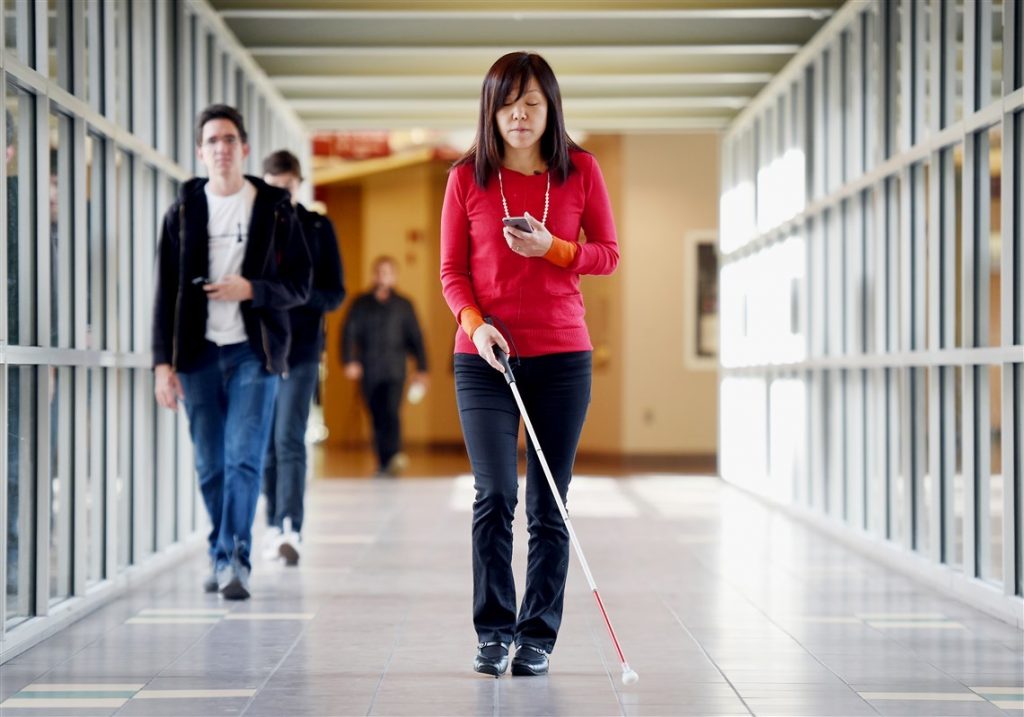Accessibility
Accessibility: The Intersection of Innovation and Inclusion
May 17, 2018 | Written by: Dr. Ruoyi Zhou
Categorized: Accessibility | IBM Research
Share this post:
On this seventh Global Accessibility Awareness Day, let’s talk, think and learn about digital accessibility, inclusion and people with disabilities. As a researcher, I enjoy technology, especially when it comes to helping people with disabilities. Over the years, our team has invented and developed many new technologies that enable accessibility. I would like to share a few here.
Guiding the Blind
 IBM Research is the innovation engine of IBM – and accessibility, quite often, is a catalyst for innovation. As the proverb goes, “necessity is the mother of invention.” One example: The amazing project led by Dr. Chieko Asakawa , an IBM Fellow and a blind researcher: A Smartphone Guide for the Blind . This project combines artificial intelligence (AI), computer vision, image recognition, location technology, mobile technology and voice navigation to help visually impaired people find places independently. For visually impaired people navigating and getting where they need to go, location technology with four to five meters of precision is not sufficient. Our solution offers high precision location technology with one to two meters of accuracy.
IBM Research is the innovation engine of IBM – and accessibility, quite often, is a catalyst for innovation. As the proverb goes, “necessity is the mother of invention.” One example: The amazing project led by Dr. Chieko Asakawa , an IBM Fellow and a blind researcher: A Smartphone Guide for the Blind . This project combines artificial intelligence (AI), computer vision, image recognition, location technology, mobile technology and voice navigation to help visually impaired people find places independently. For visually impaired people navigating and getting where they need to go, location technology with four to five meters of precision is not sufficient. Our solution offers high precision location technology with one to two meters of accuracy.
Social interaction can also be a big challenge for the visually impaired. With advanced computer vision, the app can tell users not only who’s coming their way but also the person’s facial expression. This allows the user to greet the person with confidence.
Improving Reading Comprehension
Cognitive disabilities are often overlooked. Today’s accessibility standards and policies largely address physical disabilities. To help people with cognitive disabilities, we developed Content Clarifier, which uses machine learning, natural language processing and Watson technology to transform digital content to better suit an individual’s preferences and capabilities by simplifying, summarizing or augmenting content. This solution also helps those learning English as a second language. We are currently working with a school for students with learning disabilities, and the initial results show encouraging improvements in students’ reading comprehension and writing skills. We hope this technology can be used to improve productivity for people with disabilities at work as well as at school.
Accommodating Employees with Disabilities
To help create an inclusive and productive work environment, we joined forces with West Virginia University’s Center for Disability Inclusion and the Job Accommodation Network. Together, we developed a first generation Mobile Accommodation Solution, a case management app to help businesses better accommodate employees with disabilities. This app is now available in the Apple App Store and the Google Play Store.
Our long-term vision is to collect data through crowdsourcing via this app. By applying machine learning and other AI technology, we can develop standardized disability taxonomy over time and, more importantly, optimize accommodations for employees with disabilities. We would much appreciate your using our tool, sending us your feedback, and working with us on this exciting project to make all workplaces more inclusive.
Inclusion is IBM’s heritage. Innovation is in our DNA. As the Accessibility Research team, we play a key role at the intersection of inclusion and innovation. With IBM’s leadership in AI, we are empowered to take accessibility to the next level.
____________________________
Homepage image courtesy of Pixabay.

Director of Accessibility Research, IBM
Meet the Newest IBM Fellows
Since the first class of IBM Fellows in 1962, IBM has honored its top scientists, engineers and programmers, who are chosen for this distinction by the CEO. Among the best and brightest of IBM’s global workforce are 12 new IBM Fellows who join 293 of their peers who have been so recognized over the last […]
How IBM is Advancing AI Once Again & Why it Matters to Your Business
There have been several seminal moments in the recent history of AI. In the mid-1990s, IBM created the Deep Blue system that played and beat world chess champion, Garry Kasparov in a live tournament. In 2011, we unveiled Watson, a natural language question and answering system, and put it on the hit television quiz show, […]
Amplifying the Power of Debate with AI
French essayist, Joseph Joubert, wrote in 1896: “It is better to debate a question without settling it than to settle a question without debating it.” For the last 15 years, I’ve led the nation’s most popular debate organization, ProCon.org. While our public charity has served more than 180 million people since 2004, our obsession with […]


